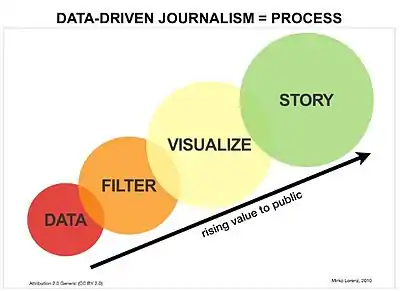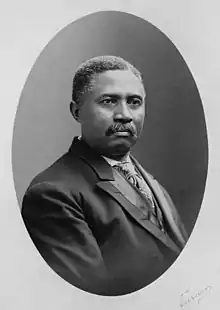Portal:Journalism
The Journalism Portal Kaiyuan Za Bao was an official publication which first appeared in the 8th century, during the Kaiyuan era. It has been described as the first Chinese newspaper or official gazette,[1] and also as the world's first magazine.[2] Pictured is a remake of the publication. .jpg.webp) The title page of Relation aller Fürnemmen und gedenckwürdigen Historien (Account of all distinguished and commemorable stories), from 1609. The publication is recognized by the World Association of Newspapers[3] as the world's first newspaper. Journalism is the production and distribution of reports on the interaction of events, facts, ideas, and people that are the "news of the day" and that informs society to at least some degree of accuracy. The word, a noun, applies to the occupation (professional or not), the methods of gathering information, and the organizing literary styles. The appropriate role for journalism varies from countries to country, as do perceptions of the profession, and the resulting status. In some nations, the news media are controlled by government and are not independent. In others, news media are independent of the government and operate as private industry. In addition, countries may have differing implementations of laws handling the freedom of speech, freedom of the press as well as slander and libel cases. The proliferation of the Internet and smartphones has brought significant changes to the media landscape since the turn of the 21st century. This has created a shift in the consumption of print media channels, as people increasingly consume news through e-readers, smartphones, and other personal electronic devices, as opposed to the more traditional formats of newspapers, magazines, or television news channels. News organizations are challenged to fully monetize their digital wing, as well as improvise on the context in which they publish in print. Newspapers have seen print revenues sink at a faster pace than the rate of growth for digital revenues. (Full article...) Selected article –
Polygon is an American entertainment website that publishes blogs, reviews, guides, videos, and news primarily covering video games, as well as movies, comics, television and books. At its October 2012 launch as Vox Media's third property, Polygon sought to distinguish itself from competitors by focusing on the stories of the people behind the games instead of the games themselves. It also produced long-form magazine-style feature articles, invested in video content, and chose to let their review scores be updated as the game changed. The site was built over the course of ten months, and its 16-person founding staff included the editors-in-chief of the gaming sites Joystiq, Kotaku and The Escapist. Its design was built to HTML5 responsive standards with a pink color scheme, and its advertisements focused on direct sponsorship of specific kinds of content. Vox Media produced a documentary series on the founding of the site. (Full article...)Selected image Go Fishing, Tobae, February 1887 Georges Ferdinand Bigot (April 7, 1860 - October 10, 1927) was a French cartoonist, illustrator and artist. Although almost unknown in his native country, Bigot is famous in Japan for his satirical cartoons, which depict life in Meiji Japan.
Did you know...
WikiProjects
What are WikiProjects?
Selected biography – Mihail Kogălniceanu (Romanian pronunciation: [mihaˈil koɡəlniˈtʃe̯anu] ( Original reportingIn the newsGeneral images -The following are images from various journalism-related articles on Wikipedia.
Selected quoteMain topicsSubcategoriesCategory puzzle Select [►] to view subcategories
Journalism Journalism by continent Journalism by country Journalism by field Journalists Journalism lists Works about journalism Types of journalism Journalism awards Journalism conferences Copy editing Criticism of journalism Crowdfunded journalism Journalism education Fact-checking websites Freedom of the press History of journalism Impact of the COVID-19 pandemic on journalism Interviews Investigative journalism Journalism adapted into films News media Newswriting Journalism occupations Journalism organizations Press galleries Reporting specialties Sources (journalism) Journalism standards Journalism terminology Journalism stubs Featured content
Featured articles
Featured listsGood articles
Featured pictures
Featured portalsThings you can do Things you can do
Related portalsAssociated WikimediaThe following Wikimedia Foundation sister projects provide more on this subject:
Sources
Discover Wikipedia using portals
| ||||



.jpg.webp)























.jpg.webp)










.png.webp)



















%252C_1896.jpg.webp)
.jpg.webp)








_cover.jpg.webp)



_-_Restoration.jpg.webp)





